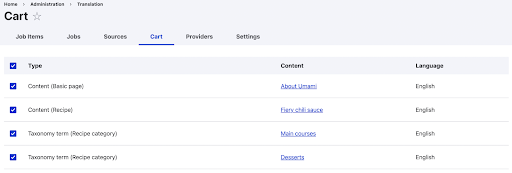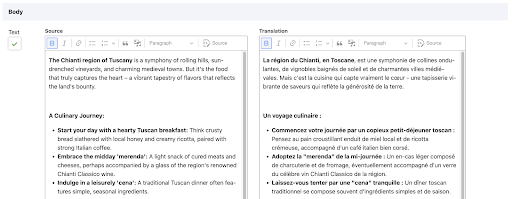Sign up to receive our AI-Assisted Translation webinar recording in your inbox and see it in action.
A multilingual website is a powerful tool for engagement, accessibility, and global reach. Making content available in multiple languages expands your audience and, in some places, helps you comply with legal requirements. However, maintaining multilingual content comes with its own set of challenges, from high costs to workflow complexity.
Drupal has multilingual capabilities built into its core, making it a favourite choice for governments and international organizations. Adding in AI-powered translation assistance helps make it easier to translate your website content, and maintain quality translations.
As an agency based in Montreal and a staff that speaks over 29 languages, Evolving Web has a healthy skepticism about machine translation. In this post, we outline the role we think automated translation can play in a translation that results in quality results. And we also discuss the limitations of this solution and the role of human translators and the value of keeping humans in the loop.
Why a Multilingual Website Matters
A well-executed multilingual strategy offers numerous benefits:
- Global Reach: Expand your audience by catering to users from different regions and linguistic backgrounds, better SEO across languages
- Compliance: Ensure your website meets legal and policy requirements for multilingual content.To comply with the Official Languages Act, all Canadian organizations, including businesses, government entities, and non-profits, are required to ensure that any public-facing documents – such as press releases, manuals, websites, and printed materials – are available in both French and English.
- Accuracy & Control: Avoid inaccuracies from automated browser translations and retain full control over how content is presented in different languages.
The Challenges of Managing Multilingual Content
While a multilingual website offers clear advantages, traditional translation methods often pose hurdles, including:
- High Costs: Professional translation services can be expensive, especially for websites with frequent content updates.
- Time-Consuming Processes: Manual translations slow down content updates, delaying launches and requiring continuous maintenance. Translations are often out of date.
- Scalability Issues: As websites grow, managing translations across multiple pages and languages becomes increasingly complex.
- Workflow Management: Coordinating translations, tracking content updates, and ensuring consistency across languages can be error-prone and inefficient.
How AI-Powered Translation in Drupal Solves These Challenges
Before we get into the details of AI translation, Drupal itself provides first-class support for multiple languages right out of the box. It’s one of the main reasons that I started using Drupal, how baked-in and flexible the language support is. Unlike other systems that rely heavily on third-party plugins, Drupal’s multilingual functionality is deeply integrated into its core, making it highly flexible and scalable for international organizations. Its four key multilingual modules—Language, Interface Translation, Content Translation, and Configuration Translation—allow full localization of both user-facing content and administrative settings.
The built-in language negotiation system supports multiple detection methods, including URL, session, and browser settings, ensuring users get the right language experience automatically. Drupal also provides granular translation workflows, API support for third-party translation services, and seamless integration with structured content models, making it an ideal choice for developers building enterprise-grade, multilingual digital experiences that need efficiency, performance, and maintainability at scale.
With that said, Drupal multilingual support expects you to bring your own translations. That’s where AI comes in to make things easier.

Here’s How It Works:
We developed a custom AI-assisted translation module that centralizes this process with the help of the Translation Management Tool module. The conventional translation process often lags behind initial content creation, but the AI-translation tool aims to provide instantaneous translations. Traditionally, translating a page involves navigating different parts of the Drupal site. Here are some details of how it works:
- Automatic Translation of Referenced Elements: When a translation is requested, the tool ensures that all associated elements—such as images, metadata, and embedded tags—are translated alongside the main content.
- Centralized Translation Management: From a dedicated translation overview page, users can select specific content types, configurations, and interface text for translation.
- Real-Time Translation Status Tracking: The module displays the current translation status, indicating which languages are complete and which require updates (e.g., Spanish translations are available, but French translations are missing).
- Built-in Human Review Options: For sensitive or high-accuracy content, users can manually review and refine AI-generated translations before publishing. The overview page highlights which translations still need human verification.
- Continuous Translation Automation: To minimize delays in multilingual content updates, the tool supports "continuous translation jobs." This feature automatically detects and translates newly created or updated content in real time.

ROM’s Bilingual Experience, Powered by AI
As part of the Royal Ontario Museum's (ROM) digital transformation, we integrated an AI-powered Drupal translation tool to streamline the management of its extensive bilingual content. As one of Canada’s largest and most visited museums, ROM regularly updates a vast amount of information—including exhibition details, event listings, educational resources, and research materials—which all need to be made available in both English and French within tight timeframes.
To meet this challenge, our solution automates translations while allowing for human review and refinement, ensuring linguistic accuracy and preserving the nuanced terminology required for museum content. This tool empowers ROM’s content team to rapidly translate and update pages, significantly reducing manual effort while maintaining consistency across hundreds of pages. By incorporating AI-driven translation workflows, ROM can efficiently scale its multilingual offerings, ensuring that its rich collection and research remain accessible to a broad, diverse audience—including visitors, scholars, and educators—without the bottlenecks of traditional translation processes.
Avoid Common Translation Pitfalls
Many organizations overlook key elements when translating their websites, leading to incomplete or inconsistent multilingual experiences. AI-powered translation tools in Drupal help address these challenges by:
- Ensuring Configuration & Interface Texts Are Translated: Critical UI elements and settings often go untranslated, creating a fragmented user experience.
- Automating Content Translation While Maintaining Control: AI-generated translations serve as a starting point, allowing content editors to refine and ensure accuracy before publishing.
-
Handling Related Entities: Linked content, such as referenced pages and media, is seamlessly translated to maintain consistency across the site.

Content teams can review and edit AI translate fields before accepting the translations.
See It in Action
Managing multilingual content doesn’t have to be complex or costly. With Drupal’s AI translation capabilities, you can streamline your workflow, reduce translation costs, and improve content accuracy.
Want to learn more? Sign up to receive our webinar recording!

